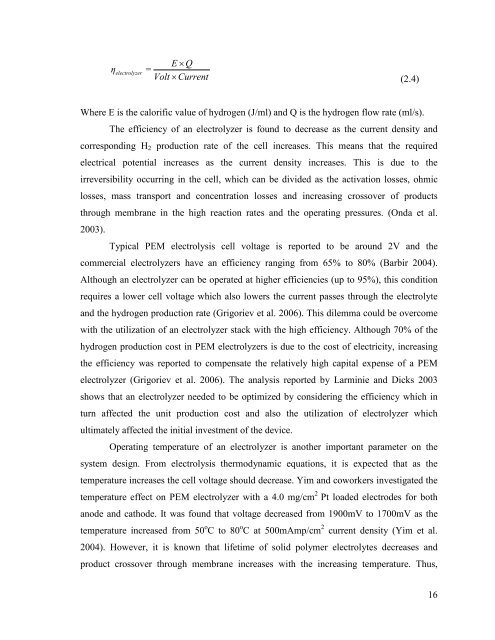hydrogen production from water using solar cells powered nafion ...
hydrogen production from water using solar cells powered nafion ...
hydrogen production from water using solar cells powered nafion ...
You also want an ePaper? Increase the reach of your titles
YUMPU automatically turns print PDFs into web optimized ePapers that Google loves.
ηelectrolyzer E × Q<br />
=<br />
Volt × Current<br />
(2.4)<br />
Where E is the calorific value of <strong>hydrogen</strong> (J/ml) and Q is the <strong>hydrogen</strong> flow rate (ml/s).<br />
The efficiency of an electrolyzer is found to decrease as the current density and<br />
corresponding H2 <strong>production</strong> rate of the cell increases. This means that the required<br />
electrical potential increases as the current density increases. This is due to the<br />
irreversibility occurring in the cell, which can be divided as the activation losses, ohmic<br />
losses, mass transport and concentration losses and increasing crossover of products<br />
through membrane in the high reaction rates and the operating pressures. (Onda et al.<br />
2003).<br />
Typical PEM electrolysis cell voltage is reported to be around 2V and the<br />
commercial electrolyzers have an efficiency ranging <strong>from</strong> 65% to 80% (Barbir 2004).<br />
Although an electrolyzer can be operated at higher efficiencies (up to 95%), this condition<br />
requires a lower cell voltage which also lowers the current passes through the electrolyte<br />
and the <strong>hydrogen</strong> <strong>production</strong> rate (Grigoriev et al. 2006). This dilemma could be overcome<br />
with the utilization of an electrolyzer stack with the high efficiency. Although 70% of the<br />
<strong>hydrogen</strong> <strong>production</strong> cost in PEM electrolyzers is due to the cost of electricity, increasing<br />
the efficiency was reported to compensate the relatively high capital expense of a PEM<br />
electrolyzer (Grigoriev et al. 2006). The analysis reported by Larminie and Dicks 2003<br />
shows that an electrolyzer needed to be optimized by considering the efficiency which in<br />
turn affected the unit <strong>production</strong> cost and also the utilization of electrolyzer which<br />
ultimately affected the initial investment of the device.<br />
Operating temperature of an electrolyzer is another important parameter on the<br />
system design. From electrolysis thermodynamic equations, it is expected that as the<br />
temperature increases the cell voltage should decrease. Yim and coworkers investigated the<br />
temperature effect on PEM electrolyzer with a 4.0 mg/cm 2 Pt loaded electrodes for both<br />
anode and cathode. It was found that voltage decreased <strong>from</strong> 1900mV to 1700mV as the<br />
temperature increased <strong>from</strong> 50 o C to 80 o C at 500mAmp/cm 2 current density (Yim et al.<br />
2004). However, it is known that lifetime of solid polymer electrolytes decreases and<br />
product crossover through membrane increases with the increasing temperature. Thus,<br />
16

















